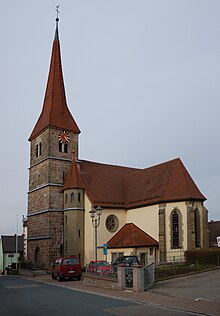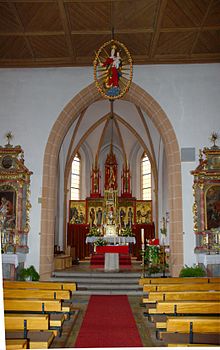St. Nikolaus (Mitteleschenbach)
St. Nikolaus is a Roman Catholic church named after St. Nicholas of Myra in Mitteleschenbach ( Herrieden dean's office of the Eichstätt diocese ).
Parish
It is unclear when the double patronage church was consecrated to St. Nicholas and St. Sola . There is a known church consecration in Eschelebach (between 1057 and 1075 by Bishop Gundekar II. ) And in Eskenbach (between 1182 and 1196 by Bishop Otto ). Since a pastor Ezzo is attested for the period 1157 to 1161 in Mitteleschenbach, it can probably be assumed that the church was consecrated earlier. The bishop of Eichstätt acquired the right of patronage in 1268 from Engelthal Monastery by exchanging a patronage right in Offenhausen , which was closer to the monastery. Brandenburg-Ansbach tried again and again to dispute this right of patronage from the Eichstätter.
Mitteleschenbach was probably independent from the beginning, but possibly a branch of Windsbach, which could be indicated by an annual procession. The Solapatrozinium could indicate a connection to the Solnhofen Monastery , which was founded by the Benedictine Abbey of Fulda . Mitteleschenbach itself originally had St. Valentin (Obererlbach) as a branch. Around 1800 the places Adelmannsdorf , Bremenhof , Gersbach , Ismannsdorf , Käshof , Klappermühle and Speckheim were parish to Mitteleschenbach.
The parish includes the St. Walburga cemetery church , the chapels Am Gersbacher Weg , Am Kirchenweg , Am Reisig , An der Eschenbachstraße , At the intersection of Kermgasse / Bergstraße , An der Mönchswaldstraße , An der Rathausstraße , An der Winkelhaiderstraße , St. Konrad , St. Willibald , The Crucified Savior and The Good Shepherd .
In 1928 the St. Bonifatius branch (Windsbach) was established , which was appointed curate in 1952 and made an expositur in 1961 . St. Boniface has been an independent parish since 1975.
St. Nikolaus belongs to the parish association Wolframs-Eschenbach.
Church building
St. Nicholas was originally a Gothic choir tower church . It was badly damaged during the Thirty Years War and had to be renovated in 1701/02. In 1895, because the church was too small for the community, a hall with a 5/8 choir was added to the south and the original hall became the transept of the church. The two hall buildings with a gable roof are at right angles to each other and form a cross. There are smaller extensions in the south-west, south-east and north-east corners. The main portal of the church is on the north side. The main nave and the choir have pointed arch windows. In the west there is a rectangular four-storey tower with a west portal and a pointed roof, next to it a smaller octagonal tower, the top of which extends to the third storey of the main tower. The consecration took place on May 10, 1900.
The hall closes off flat on the inside with a wooden ceiling and forms a T-shape with the transept. The south side is connected to the rib-vaulted choir by a pointed arch arcade. In this there is a high altar made of wood with an attachment. To the left and right of the choir arch are two side altars, above the arch there is a sculpture of Regina Coeli . An organ gallery has been inserted on the west side of the transept. Various figures of saints and paintings of the Way of the Cross are attached to the walls. The pews are modern, the entire interior was probably from the end of the 19th century with the exception of a 15th century wooden cross attached to the altar and three saints of Nicholas, Bartholomew (Sola?) And Margaretha, which originally stood in the Tannhauser Church. The organ installed at the turn of the century served as a long-term provisional facility. In 1989 a new building was built by Friedrich Kreuzer from Munich ( WRK organ building ) at a cost of 200,000 DM .
Bells
In 1912 a new bell was designed for the church, which added three new bells to an existing old bell. In 1917 a courageous fellow citizen hid part of the bells. Nevertheless, two bells were drafted in the First World War . The remaining bells were able to do their job again after the end of the war and the war loss was replenished.
In 1943, all but one of the bells were withdrawn during the Second World War . After the war, a new bell was added to the existing one. It was not until 1976 that four new bells with a value of 70,000 DM with 1115, 780, 550 and 445 kg were procured.
literature
- Manfred Jehle: Church conditions and religious institutions on the upper Altmühl, Rezat and Bibert: Monasteries, parishes and Jewish communities in the Altlandkreis Ansbach in the Middle Ages and in modern times (= Middle Franconian Studies . Volume 20 ). Historical Association for Middle Franconia, Ansbach 2009, ISBN 978-3-87707-771-9 , p. 198-201 .
- Hansgeorg Klauss et al. (Ed.): The district of Gunzenhausen . Verl. F. Authorities and Economy Hoeppner, Aßling-Pörsdorf / Obb. 1966, DNB 456843604 , p. 72-73 .
Web links
- Mitteleschenbach on the website bistum-eichstaett.de
Individual evidence
- ↑ a b M. Jehle, p. 198.
- ↑ M. Jehle, p. 199.
- ↑ a b M. Jehle, p. 200.
- ↑ The organ at www.mitteleschenbach.de, accessed on September 16, 2017
- ↑ The bell story at www.mitteleschenbach.de, accessed on September 16, 2017
Coordinates: 49 ° 12 ′ 44.2 " N , 10 ° 47 ′ 51.9" E


